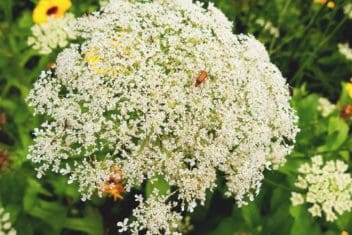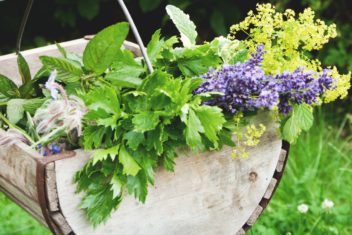There are some aspects of your garden that you’d really like to stand out and others that you’d like to hide. Flowers, vegetables, statues, and water features are stars of the show. Garden hoses, however, tend to stand out in a less-than-stellar way.
This is especially the case for drip irrigation lines and soaker hoses. While hoses can be tucked away or hung up on decorative hooks after use, drips and soakers stay in place. This can really detract from your garden’s overall appearance.
Let’s take a look at a few ways to camouflage these bad boys so they can do their work without causing visual distractions.
1. Color Camouflage
You may have noticed that garden hoses come in a variety of hues. Sure, the most common ones are black or brown, but you can find them in just about any color imaginable.
One of the easiest ways to camouflage your surface hoses and drip lines is to get them in colors that blend in with their surroundings.
For example, if you plan on placing surface drip lines on dark earth—like the rich organic compost you’ll use in vegetable gardens—get yourself a few brown or black hoses.
These will meld into the background rather than standing out against it in stark contrast.
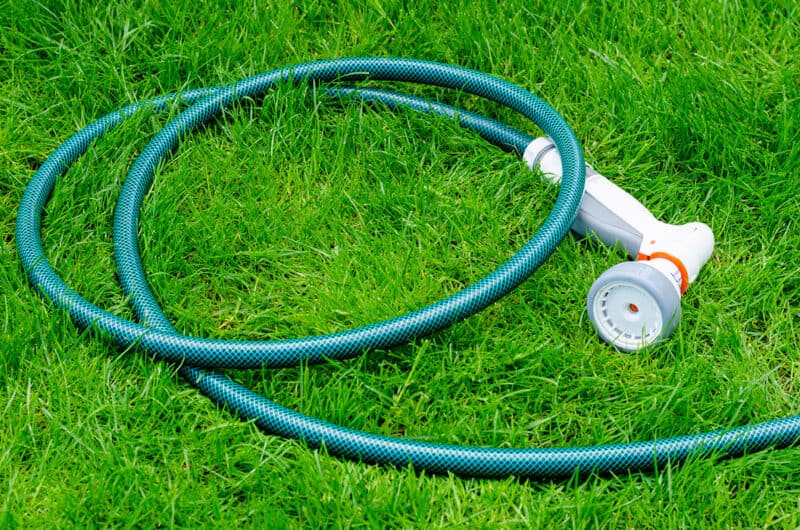
If you’re using drip hoses to hydrate your lawn, then choose grassy green hoses instead. Just be careful not to trip over them when you’re out in the yard. Also, make sure to tell other family members when the hose is out.
You’ll save yourself a lot of stress and cut back on swearing exponentially if you tell your kids the hose is out there before they go and mow the lawn.
2. Give Them a Camo Makeover
Do you feel like getting creative with your garden hose camouflage? Then you can get out some spray paints and go nuts. Create a mottled effect on rubber hoses with acrylic spray paints.
Alternatively, you can actually find camo garden hoses now and then. They’re usually not the best quality, but they meld well with just about any type of ground cover.
Of course, if you’d like to get your craft on, but you don’t want to paint the hoses, there’s an alternative… you could sew some hose socks.
Seriously, go to a thrift shop and buy a few pairs of used camo trousers. Then cut them into rectangles and sew them all together to create a sleeve that’s long enough to cover most of your hose.
You can also get camo webbing or other coverings and get crafty with that too. Let your imagination reign, here!
3. Buy Clear Hoses
This might seem like a cheeky approach to camouflage your garden hoses, but hey—it works. There are a lot of clear PVC garden hoses available, whether for standard watering or drip irrigation.
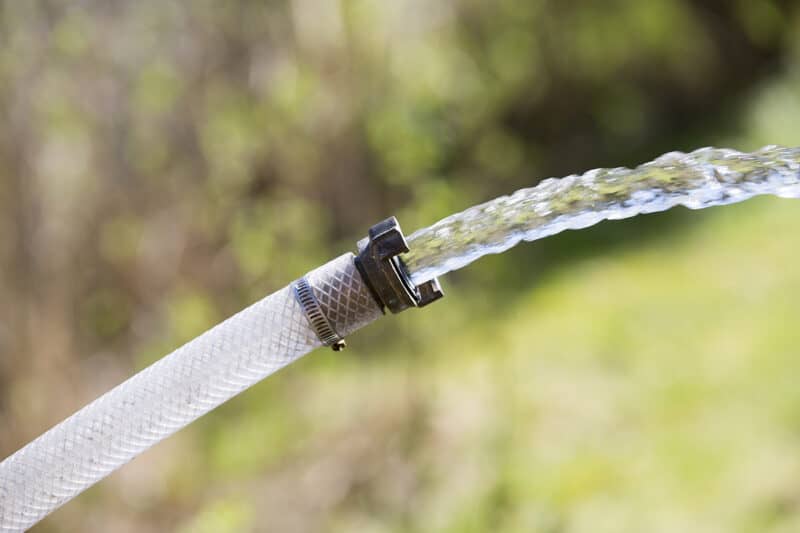
Although they can be a bit pricier than standard rubber hoses, they have the benefit of melding into whatever landscape background they’re placed against. As an added bonus, you can also easily see if they get clogged.
The downside is that they should only be used in temperate climates. PVC hoses break down easily in extreme heat or cold. Use these if you’re gardening in zones 5-9, or you’ll need to replace them a few times a season.
4. Cover Hoses with Mulch
As I’ve mentioned in my article on desert gardening, mulch is ideal for hiding (and protecting) a garden hose.
This works well both in a desert environment and in an area that gets extremely cold. Mulch can protect hoses from cracking or melting in high heat and from breaking if you live in zones 4 and lower.
If your drip line hoses are a similar color as their surroundings, then you only need to mound a bit of mulch over them. In contrast, if they’re a significantly different hue, they’ll need a bit more work.
Try to cover your hoses with 2 to 3 inches of mulch. This will camouflage them well, while also keeping that vital hydration in the soil around them.
Just be sure to do your research ahead of time, so you choose the right mulch for the right area. The last thing you want to do is encourage the wrong nutrients to seep into the soil.
5. Bury Them
Do you know what’s great about dirt? It’s great for burying things. Like hoses! This works particularly well for drip lines, as the water they offer can be soaked up even better when they’re submerged into the earth.
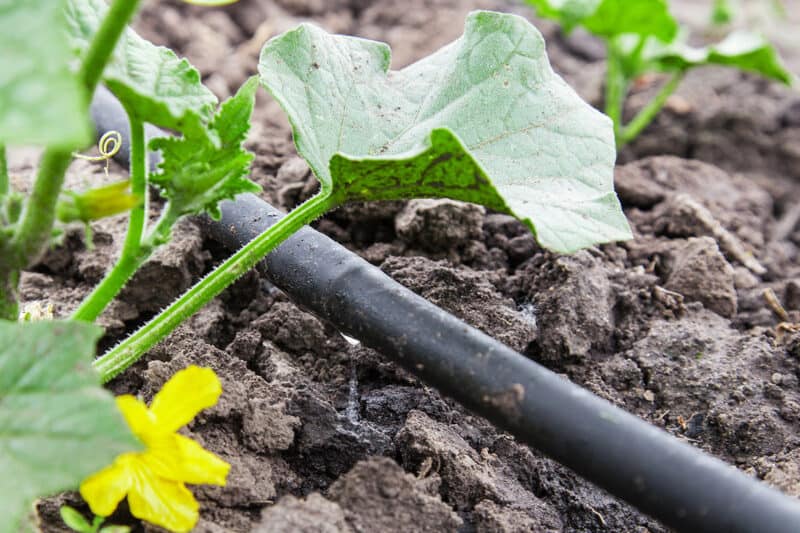
It doesn’t matter what color hose you get for buried irrigation hoses. After all, they’ll be covered with at least 4-5 inches of soil. I’d recommend that you get hoses that are a slightly different hue than the surrounding earth.
This way, they’re easier to see if you need to dig down a bit, which is great for reducing potential hose damage.
I can’t tell you how many times I’ve cut deeply into submerged hoses while working with sharp spades or trowels in the garden. If you’ve got a dark brown hose in dark brown soil, it’s a lot harder to see while you’re working.
Choose submerged drip hoses in hues like orange if you can find them.
Alternatively, if only earth-toned hoses are available, then choose a tone that’s different from their surroundings. For example, aim for a black hose in sandy soil, or a light brown or sand-colored one for dark earth.
6. Run Them Beneath Raised Beds
This is a clever technique I learned to camouflage garden hoses that works well in backyard farms and other urban homesteads. Whether you’re short on space or just trying to maximize it, make sure everything in the garden pulls double duty.
When you’re planning your garden, take into account where your raised beds are going to be. Then, consider constructing them so that you can run your drip lines below or through them.
This technique allows your hoses to water the raised beds at ground level, beneath their roots. While doing so, they’re also making their way to other parts of the garden without being eyesores.
7. Store Them Inside Outdoor Furniture
If your garden hoses and drip lines aren’t permanent installations, consider some dual-purpose outdoor furniture to camouflage them. For example, wooden garden benches are brilliant places to store all manner of garden equipment.
Place a few of these around your garden, and coil your hoses inside them when they’re not in use. Just try to keep them out of direct sun, if possible. Hoses are expensive, and you don’t want to bake them inside wooden hot boxes.
Of course, if you’re using a stainless steel hose (which I recommend for zones 9 and over, or zones 4 and below), then you can store them wherever you like. Those beasts can withstand just about anything.
Remember that one of the most distracting things about hoses and drip lines is the sound of water running into them from the source. If possible, when you’re planning your garden design, try to keep seating and socializing areas away from the hoses’ spouts.
You (and others) will be far less distracted by the hoses if you can’t hear them and less likely to keep looking for the source of the irritating water-rushing sounds.
Hopefully these options have given you some decent inspiration on how to camouflage your own garden hoses and drip lines.
Ultimately, remember that form follows function in just about every aspect of gardening. Aesthetics are nice and all, but as long as your garden is doing as it’s meant to and will be feeding and healing yourself and your family, that’s what matters.
Sure, some of these hoses and drip lines can be a bit unsightly, but the important thing is that they’re bringing life-giving water to your plants.
As a final thought, if you’re really worried about unsightly hoses and drip systems at ground level, you can always hang really bizarre things in the trees nearby.
I guarantee you that anyone who’s wandering through your garden will be far too distracted by the flaming pink flamingos or strangely shaped fairy lights up there to pay any notice to your garden hoses.


